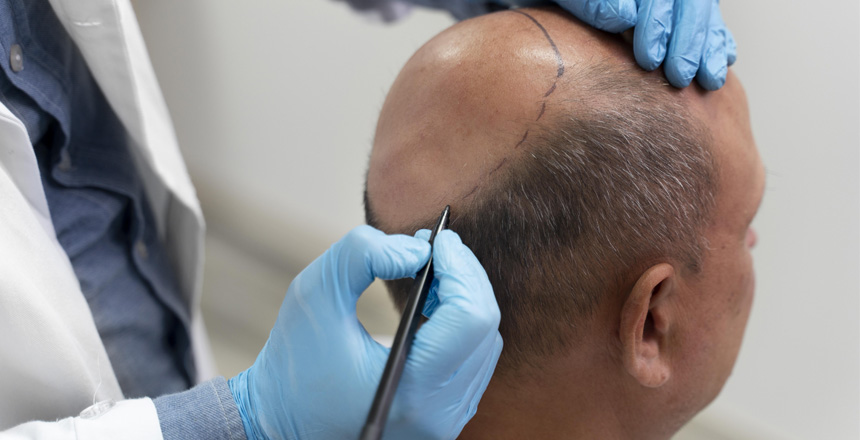1. Understanding Hair Transplantation
Before diving into your options, it’s important to understand how hair transplants work. Hair transplant surgery involves moving hair from one part of your body (usually the back or sides of your scalp) to the areas where you’re experiencing hair loss.
The two main methods are:
- Follicular Unit Transplantation (FUT): A strip of scalp is removed, and individual follicular units are transplanted to the desired area.
- Follicular Unit Extraction (FUE): Hair follicles are harvested individually from the donor area and transplanted directly.
Both methods have their pros and cons, which we’ll break down in the next section.
2. FUT vs. FUE – Which is Right for You?
- FUT (Follicular Unit Transplantation):
- Pros: Typically more affordable, can transplant larger numbers of follicles in one session.
- Cons: Leaves a linear scar on the donor site, longer recovery time.
- FUE (Follicular Unit Extraction):
- Pros: No linear scar, quicker recovery time, less invasive.
- Cons: Typically more expensive, can be time-consuming for larger procedures.
Your choice depends on your hair type, the extent of hair loss, your budget, and the skill of the surgeon. FUE has grown in popularity because of its minimally invasive nature and quicker recovery time, but FUT may still be the better choice for those who need a significant number of grafts.
3. How to Choose the Right Surgeon
A successful hair transplant largely depends on the expertise of your surgeon. Here are some key factors to consider:
- Board Certification: Ensure your surgeon is certified by relevant boards such as the International Society of Hair Restoration Surgery (ISHRS).
- Experience: How many years of experience does the surgeon have in hair transplantation? Look for someone with a solid track record.
- Portfolio of Results: Ask to see before-and-after photos of previous patients to get an idea of the surgeon’s work.
- Reviews and Testimonials: Look for genuine reviews on trusted platforms like RealSelf, Google, or Yelp.
- Technology and Techniques: Check if the clinic uses the latest technologies and methods such as robotic FUE, advanced laser therapy, or high-resolution imaging for accurate graft placement.
4. Cost of Hair Transplants in the US (2024 Update)
Hair transplant costs vary depending on location, the method chosen (FUT or FUE), and the extent of the procedure. Here’s what you can generally expect in the US in 2024:
- FUE: Typically costs between $4,000 to $15,000.
- FUT: Costs can range from $3,500 to $12,000.
The number of grafts you need also impacts the price. The average cost per graft is around $4 to $6. Some clinics offer payment plans or financing options to make the procedure more affordable.
5. Factors That Affect Pricing
- Location: Hair transplants are generally more expensive in major metropolitan areas like New York, Los Angeles, or Miami.
- Clinic Reputation: Renowned clinics or surgeons with celebrity clients may charge higher rates.
- Technology: Clinics using cutting-edge technologies may have higher prices, but these innovations often lead to better results and less downtime.
- Number of Grafts: The more grafts you need, the higher the overall cost. It’s important to know that sometimes it’s worth paying for quality, especially for a procedure as personal and visible as hair restoration.
6. Risks and Considerations
Hair transplant surgery is considered safe when performed by an experienced surgeon, but like any medical procedure, there are risks. Common risks include:
- Infection: Rare but possible, can usually be managed with antibiotics.
- Scarring: FUT leaves a linear scar, while FUE may leave tiny, less noticeable scars.
- Shock Loss: Temporary hair loss after surgery, which usually resolves on its own.
- Unnatural Hair Growth Patterns: Can occur if the surgeon is inexperienced or doesn’t follow the natural direction of your hair growth.
To minimize risks, follow all pre- and post-operative instructions, and choose a reputable surgeon.
7. Recovery and Downtime
The recovery process varies between individuals, but you can expect:
- Initial Recovery: Swelling, redness, and scabbing in the transplant area for a few days to a week.
- Hair Shedding: Don’t panic if transplanted hair sheds in the first 2-3 weeks—this is a normal part of the process.
- Full Results: It typically takes 9 to 12 months for the full results to be visible, as hair grows in cycles.
Most people can return to work within a week after an FUE procedure and 10 to 14 days after FUT. Your surgeon will provide specific aftercare instructions to ensure proper healing.
8. Alternative Treatments to Consider
Hair transplantation is not the only solution for hair loss. Here are some alternatives you might want to explore:
- Minoxidil (Rogaine): Over-the-counter topical treatment that promotes hair growth.
- Finasteride (Propecia): Prescription oral medication that can slow hair loss.
- Platelet-Rich Plasma (PRP) Therapy: A newer treatment involving injections of your own plasma into the scalp to promote growth.
- Laser Therapy: Low-level laser therapy is used to stimulate hair follicles and promote regrowth.
Many patients choose to combine treatments for the best results.
9. FAQs for Hair Transplant Candidates
Q: Is a hair transplant permanent? A: Yes, the transplanted hair is usually permanent since it’s resistant to hair loss. However, you may still experience thinning in other areas as you age.
Q: Am I a good candidate for a hair transplant? A: Ideal candidates are those with healthy hair growth at the back or sides of the scalp that can serve as donor areas. Candidates should also have realistic expectations about the outcome.
Q: Does it hurt? A: The procedure is performed under local anesthesia, so you shouldn’t feel pain during surgery. Post-operative discomfort can be managed with pain medication.
10. Final Tips for 2024 Hair Transplant Seekers
- Consult Multiple Clinics: Don’t settle on the first consultation. Shop around, compare prices, and ask lots of questions.
- Stay Realistic: Understand that hair transplants can improve your appearance, but perfection is not guaranteed.
- Plan Ahead: The process takes time—research thoroughly, consult with experts, and plan your finances accordingly.
- Look into Financing Options: Many clinics offer payment plans or third-party financing, making the process more manageable financially.
A hair transplant can be a transformative decision, and with the right information and planning, you can achieve results that enhance your confidence and appearance. Follow this guide, consult with reputable surgeons, and you’ll be on your way to a fuller head of hair in 2024!




